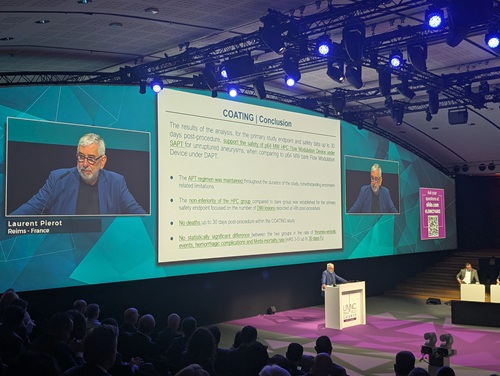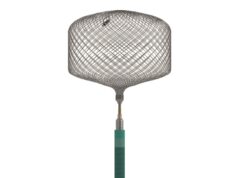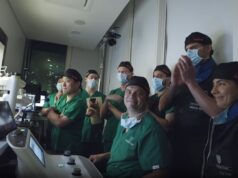
Primary-endpoint findings and initial safety data from the COATING trial—presented by principal investigator Laurent Pierot (Reims University Hospitals, Reims, France) at the 2025 LINNC Paris course (2–4 June, Paris, France)—suggest comparable thromboembolic event rates between surface-modified and ‘bare’ flow-diverter treatments, potentially laying the groundwork for aneurysm patients to receive less burdensome antiplatelet regimens in the future.
In the randomised COATING trial, patients with unruptured or recanalised intracranial aneurysms indicated for endovascular flow-diverter placement were randomised 1:1 to one of two groups, receiving treatments involving either the surface-modified p64 MW Hydrophilic Polymer Coating (HPC) flow-modulation device (WallabyPhenox) alongside single antiplatelet therapy (SAPT), or the regular, ‘uncoated’ version of the p64 MW device alongside dual antiplatelet therapy (DAPT).
Across 15 European centres, the trial enrolled 171 patients with a single aneurysm who had a pretreatment modified Rankin scale (mRS) score of 0–2, with long-lasting antiplatelet therapy and prior stent or flow-diverter placement being among key exclusion criteria. The absolute number of core lab-adjudicated diffusion-weighted imaging (DWI) lesions—visualised on magnetic resonance imaging (MRI) within 48 hours of the index procedure—served as its primary endpoint, with a number of safety- and efficacy-related secondary endpoints being assessed at 30 days, six months, and one year.
New COATING data
Pierot noted in his LINNC Paris presentation that the most common aneurysm location was the internal carotid artery (ICA), and the majority of patients included in the study had small aneurysms (≤10mm)—showing, in his view, that the main indication for flow-diverter treatment is no longer large or ‘giant’ aneurysms. He further relayed that roughly one third of patients were treated with prasugrel while closer to two thirds received ticagrelor.
Some 83 patients in the HPC group and 88 patients in the bare-stent group were available for the trial’s intention-to-treat (ITT) analysis. Regarding their primary endpoint, the COATING investigators found no statistically significant difference in the mean number of new DWI lesions between the two study groups, with six in the HPC group and 5.3 in the bare-device group (p<0.0001), establishing non-inferiority in patients treated with the surface-modified p64 MW HPC device under SAPT. In addition, the number of patients with observed DWI lesions was 41 (49.4%) in the HPC group compared to 49 (56.3%) in the bare-device group, resulting in a rate of 52.9% across the study’s ITT population.
Moving on to discuss clinical endpoints, Pierot reported statistically comparable 30-day morbimortality occurrences between the two groups, as per similar rates of both mRS 0–2 and mRS 3–5. In addition, no deaths (mRS 6) occurred in either group at 30 days. In terms of thromboembolic complication rates per patient up to 30 days, the investigators also observed similar proportions between the two study groups—a finding maintained across intraprocedural and postprocedural events alike. Pierot further reported that no intraprocedural cerebral haemorrhagic complications were seen in either group, while rates of postprocedural haemorrhagic events—both cerebral and peripheral—were statistically similar between groups as well.
“In conclusion, the results of this analysis of the primary study endpoint and safety data up to one month support the safety of the p64 MW HPC flow-modulation device under single antiplatelet therapy with prasugrel or ticagrelor,” Pierot added, also highlighting the “relatively important point” that homogenous antiplatelet regimens were largely maintained throughout the study.
Findings in context
Subsequently, LINNC course director Laurent Spelle (Bicêtre Hospital, Le Kremlin-Bicêtre, France) congratulated Pierot and his co-investigators on successfully conducting and completing this study. Spelle also expressed hope that COATING could represent a “first step” towards surface-modified devices being used to further reduce—or even completely remove—the burden of antiplatelet medication in aneurysm patients treated via flow diversion.
Discussions following this saw LINNC course director Jacques Moret (Bicêtre Hospital, Le Kremlin-Bicêtre, France) and Isil Saatci (Koru Hospitals, Ankara, Turkey) submit that the elevated risk of complications created by “potent” antiplatelet drugs like prasugrel or ticagrelor mean that many physicians already prefer to avoid DAPT involving these medications, even—where possible—alongside uncoated flow diverters. Moret noted that a trial incorporating usage of a surface-modified stent with aspirin alone would therefore provide more meaningful evidence.
Pierot replied by pointing out that the majority of companies developing a surface-modified flow diverter are still recommending DAPT alongside their devices, before also highlighting a previous study that attempted to evaluate treatments involving the p64 MW HPC device with aspirin only but was ultimately halted due to high rates of thromboembolic complications.
“I agree—maybe, in the end, surface modification will give us the opportunity to just use aspirin but, for the time being, I’m not sure we can do that,” Pierot added. “As Laurent [Spelle] mentioned, we go step by step, and I think the first step is to be able to move from dual to single antiplatelet treatment.”
A comment from René Chapot (Alfried Krupp Krankenhaus, Essen, Germany) alluded to the study potentially being underpowered due to its relatively small patient population and the “very low” ischaemia rates associated with these treatments. Pierot stated that this was the motive for COATING utilising an imaging-based primary endpoint, as DWI lesions are known to present more commonly (roughly 50–60% of cases) in comparison to thromboembolic events (roughly 5–10% of cases). He went on to concede that, as Chapot also suggested, a study population closer to 1,000 patients—a somewhat unrealistic target given the scarcity of eligible aneurysm patients—would likely have been needed in order to assess a clinical endpoint.
Responding to another question from the LINNC audience on the possibility of a change in thromboembolic complication rates with a surface-modified flow diverter beyond 30 days, Pierot stated that this will be a key area of interest when more long-term data from COATING’s six-month and one-year follow-up become available.
“It’s important to see how many thromboembolic complications occur after one year,” he said. “Maybe the fact we are not using the same antiplatelet regimen can potentially change the rate of complete aneurysm occlusion and, also, the use of surface modification and single antiplatelet treatment may have an impact on the rate of in-stent stenosis. So, it is very important to have these primary safety data at one month, but I agree that we still have a lot of questions.”










